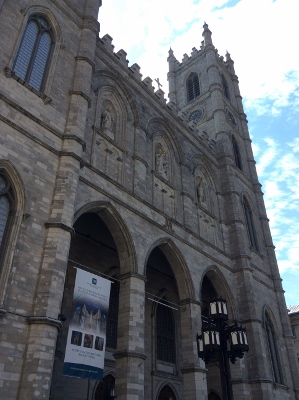Notre-Dame Roman Catholic Church / Basilica National Historic Site of Canada
Montréal, Quebec

Corner view
© Parks Canada Agency | Agence Parcs Canada, D. Desjardins, 2016.
Address :
110 Notre-dame Street West, Montréal, Quebec
Recognition Statute:
Historic Sites and Monuments Act (R.S.C., 1985, c. H-4)
Designation Date:
1989-02-24
Dates:
-
1824 to 1829
(Construction)
-
1843 to 1843
(Significant)
-
1872 to 1880
(Significant)
-
1883 to 1887
(Significant)
-
1926 to 1926
(Significant)
Event, Person, Organization:
-
Henri Bouriché
(Person)
-
Louis-Philippe Hébert
(Person)
-
Ozias Leduc
(Person)
-
James O'Donnell
(Architect)
-
John Ostell
(Architect)
-
Victor Bourgeau
(Architect)
Other Name(s):
-
Notre-Dame Roman Catholic Church / Basilica
(Designation Name)
Research Report Number:
1989-SUA, 2008-CED-SDC-32
Plaque(s)
Existing plaque: at the front entrance 110 Notre-dame Street West, Montréal, Quebec
This imposing basilica, constructed from 1824 to 1829 and completed in the early 1840s, was the first significant example of the Gothic Revival style in Canada. Built as a parish church to designs by Irish American architect James O'Donnell, it is an outstanding example of the style's early Romantic phase, characterized by the application of medieval features such as pointed arches, battlements, and pinnacles to a classically influenced, symmetrical form. The use of the Gothic Revival for such an important building heralded the prominence the style would have in Canadian architecture.
Description of Historic Place
Notre-Dame Roman Catholic Church / Basilica National Historic Site of Canada is an immense stone church built from 1824 to 1829 in the Romantic Gothic Revival style. It features massive twin towers and a Gothic-arched, recessed portico. The interior is decorated in a later and more elaborate version of the Gothic Revival style. The church faces onto Notre-Dame Street, directly across from Place d’Armes in the heart of Old Montréal. The formal recognition consists of the building on its footprint.
Heritage Value
Notre-Dame Roman Catholic Church / Basilica was designated a national historic site of Canada in 1989 because: it showcases the romantic expression of the Gothic revival Style and is the flagship of this style in Canada; the use of the Gothic Revival on a building of such importance accurately predicts the prominence that this style would have in Canadian architecture.
Built from 1824 to 1829, Notre-Dame Roman Catholic Church / Basilica was the first significant example of the Gothic Revival style in Canada. In the 1820s the parish of Notre-Dame was led by a group of prominent Montréal merchants and by the Sulpicians, a powerful Roman Catholic religious order that had historically controlled the island of Montréal as its priests and seigneurs. The Sulpicians wanted to build a new parish church that was more impressive than the recently built Roman Catholic and Anglican churches in the city. The Sulpicians called on James O’Donnell, an American Protestant architect to build a church in the latest style, with enough space to accommodate a congregation of more than 8000. The resulting Gothic Revival style church, named Notre-Dame, served all of Montréal. For the next half century it was the largest church in either Canada or the United States. Its early Gothic Revival style, which was applied to a straightforward nave plan with galleries and twin towers, marked the beginning of the style’s significance in Canadian church architecture. It represents a Romantic, non-academic approach to the style, which contrasts with the formal Ecclesiological Gothic Revival of many of Canada’s large Anglican and Roman Catholic cathedrals of the mid- to late-19th century.
The parish used many of Quebec’s most celebrated architects and artisans to help complete the decoration of the church in the 19th and 20th centuries. Architect John Ostell finished the twin towers in 1843, after O’Donnell’s death but according to the original plan. Between 1872 and 1880, O’Donnell’s interior was replaced by a more elaborate Gothic Revival decoration, designed by well-known architect Victor Bourgeau. Bourgeau commissioned French sculptor Henri Bouriché to produce the statues and reliefs for the main altar and the massive reredos along the east side of the chancel. Montréal sculptor Louis-Philippe Hébert added a pulpit between 1883 and 1887 to plans by Bouriché. In 1926, Quebec artist Ozias Leduc decorated vaults, walls, doorways and stained glass windows.
Source: Historic Sites and Monuments Board of Canada, Minutes, June 1989.
Character-Defining Elements
Key elements contributing to the heritage value of the site include: the monumental effect of the building, achieved through its large scale, traditional plan, flat façade, and the two massive towers; features typical of traditional, classically inspired designs, including the symmetrical facade, a low-pitched roof, and a general rectilinear approach; its simple interior organization, consisting of nave and galleries; its imposing façade, consisting of a triple arched portico surmounted by a blind arcade and flanked by twin squared towers; the Gothic Revival detailing applied to the façade, including niches with statuary, a crenellated parapet, octagonal colonettes finishing the corners of the towers, buttresses, pointed-arch windows, and window tracery; its early 19th-century construction technology, including, its complex wooden roof truss system, its painted lath-and-plaster vaulted ceiling, and its Montréal limestone walls; its highly decorated, Gothic Revival interior designed by Victor Bourgeau, including, the polychromatic nave, the rose windows, the Gothic tracery, the painted nave illuminated by three octagonal skylights, the ribbed vaulted ceiling, and the mahogany choir stalls; Gothic Revival decoration produced by French sculptor Henri Bouriché, including the statues and reliefs of the main altar and the massive reredos along the east side of the choir; the pulpit by sculptor Louis-Philippe Hébert; the vaulting, walls, doorways and stained-glass windows produced by Ozias Leduc; the viewscapes between the church and Place d’Armes.